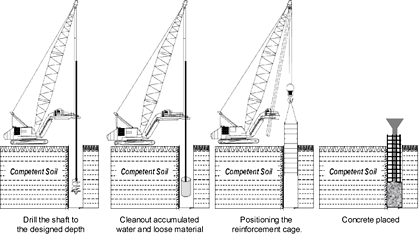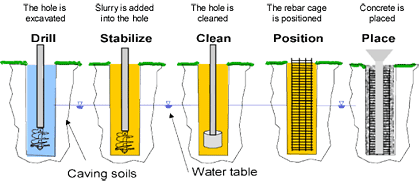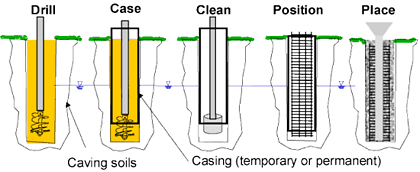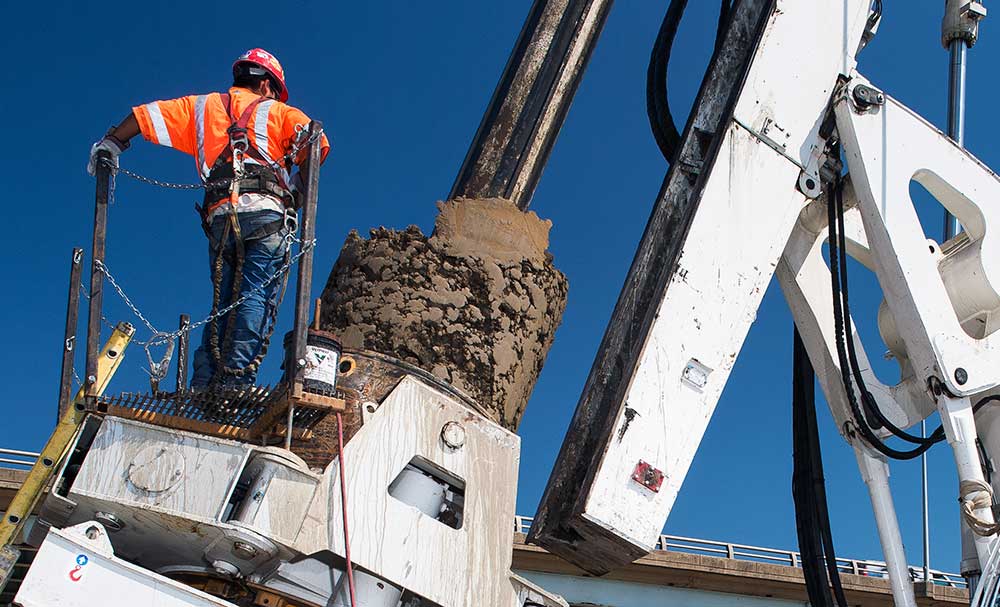Drilled Shaft Construction Methods
This [section] contains information on the three methods of drilled shaft construction.
Each of these methods is different and has their own potential problem areas and applicability. It is important for the Inspector to have an understanding of each of these processes to facilitate inspection of the shafts during construction.
What is a dry shaft?
A shaft excavation that can be excavated to its designed depth without the need for slurry or casing.
The dry construction method is used at sites where the ground water level and soil and rock conditions are suitable to permit construction of the shaft in a relatively dry excavation. and where the sides and bottom of the shaft may be visually inspected by the Engineer prior to placing the concrete.
The dry method is by far the least expensive method for drilled shaft construction. Given the choice of drilling methods, Contractors will try the dry method even in soil or rock of dubious quality.
Dry construction is generally defined by an amount of water accumulation permitted over a specified time period.
- In place Soil/rock will keep the hole walls from collapsing.
- Construction of the shaft can be in relatively dry conditions.
Dry Shaft Construction Process
The dry method consists of drilling the shaft excavation, removing accumulated water and loose material from the excavation, placing the reinforcement cage, and concreting the shaft in a relatively dry excavation.

What What is a Wet Shaft
Often called the "slurry-method", wet shaft construction is when a slurry or water is used to keep the hole stable for the entire depth of the shaft.
When Used
- When a "dry" excavation cannot be maintained
- When In-place soil/rock is unstable and deforms or collapses
- When loose material and accumulated water cannot be removed
Wet vs. Dry
- Wet is more expensive
- Wet requires more Contractor expertise
- Wet requires more equipment Wet is when there is more than 12" of accumulated water in the bottom of the shaft (typically)
- Wet precludes visual inspection of the bottom of the shaft by the Inspector
Wet Shaft Construction Process
Unlike the dry construction method, in this situation the water table may be above the shaft tip elevation or the geology consists of unstable or "caving" soils. Think of trying to dig a hole at the beach or lake near the water’s edge. The hole stays open until you reach or get just below the water table or waterline. Then what happens? It collapses.
Well the same goes for drilled shafts excavated below the water table or in unstable soils. During the drilling of the hole, a slurry is introduced that "stabilizes" the sides of the hole or casing is installed and prevents the soils from collapsing into the hole.
Upon reaching the designed shaft tip elevation, the hole is cleaned, then the rebar cage placed.

Unlike the dry shaft method, the concrete is being placed "under the water" and therefore a tremie is lowered into the hole and the concrete placed through the tremie, which is carefully removed a little at a time to avoid "breaching" the concrete.
Types of Wet Shaft Construction
There are two types of "wet" shaft construction:
| The Static Process | The Circulation Process |
| Drilled down to the piezometric level | Hole is drilled |
| Slurry introduced | Slurry level maintained at the ground surface |
| Cuttings are lifted from the hole | Cuttings and sand, is circulated to the surface, where it is cleaned and reintroduced down the hole. |
What is Slurry
What Does the Slurry Do?
- Maintains a Stable Borehole Prior to Concreting
- Maintains High Effective Stresses in the Soil while the Hole is Open (Retard Softening or Loosening)
- Facilitates Removal of Cuttings in "Circulation Drilling"
Slurry is the fluid introduced into the excavation to assist in maintaining hole stability. Generally, three basic types of "slurries", Mineral, Polymer and Water, are employed in drilled shaft construction.
In some instances, though not recommended, a blended slurry, consisting of mineral and polymer slurries is employed.
Mineral Slurry
Mineral Slurry is made from naturally occurring clay minerals.
Natural mineral clays: Bentonite, attapulgite and sepiolite
Bentonite slurries have been used commonly in drilled shaft construction in the United States since the 1960’s. Other processed, powdered clay minerals, notably attapulgite and sepiolite, have been used on occasion in place of bentonite, usually in saline ground water conditions. However, Bentonite is the most common Bentonite and other clay minerals, when mixed with water in a proper manner, form suspensions of microscopic, plate-like solids within the water. This suspension, in essence, is the drilling slurry. If the fluid pressures within the slurry column in the borehole exceed the fluid ground water pressures in a permeable formation (e.g., a sand stratum), the slurry penetrates the formation and deposits the suspended clay plates on the surface of the borehole, in effect forming a membrane, or "mudcake" that assists in keeping the borehole stable.
Polymer Slurry
Polymers are semi-synthetic or totally synthetic chemical slurries.
Drilling slurries can also be made of mixtures of chemicals called polymers and potable water. Polymers have been used in preference to bentonite in well drilling for some time in soil profiles that contain considerable clay or argillaceous (clay-based) rock, because bentonite slurries have a tendency to erode clayey rocks and to produce enlargements and subsequent instabilities in the boreholes. Polymer slurries require less conditioning before reuse than bentonite slurries and can be disposed of more inexpensively than bentonite slurries.
It is also important that polymers be kept out of contact with cement as much as possible during the construction process, since cement will cause the polymer to agglomerate.
Water
Water is used in some areas as the drilling fluid, in lieu of mineral or polymer slurry. In certain geologic conditions, water when combined with the naturally occurring subsurface materials creates it own "slurry".
Generally, the use of water must be approved by the Engineer.
A misconception by many is that because water is being used, slurry testing is not necessary. However, many local specifications mandate that if water is used, it must still meet certain slurry properties and the only way to determine the specific properties values is to test.
In some instances, though not recommended, a blended slurry, consisting of mineral and polymer slurries is employed.
What is a Cased Shaft?
The casing method is often used either when shown on the plans or at sites when construction methods are inadequate to prevent hole caving or excessive deformation. In this method the casing may be either placed in a predrilled hole or advanced through the ground by twisting, driving or vibration before being cleaned out. Casings and liners play an important role in the construction of drilled shafts, and special attention must be given to their selection and use.
Casings are tubes that are relatively strong, usually made of steel, and joined, if necessary, by welding. Liners, on the other hand, are light in weight and become a permanent part of the foundation. Liners may be made of sheet metal, plastic, or pressed fibers. While their use is much less frequent than that of casings, liners can become important in some situations.
Common situations where casing is used are:
- In generally dry soils or rocks that are stable when they are cut but which will slough soon afterwards. In such a case the borehole is drilled, and casing (a simple steel pipe) is quickly set to prevent sloughing.
- When there is a clean sand below the water table underlain by a layer of impermeable limestone or low permeability clay into which the drilled shaft will penetrate. In this case, since the overlying sand is water bearing, it is necessary to seal the bottom of the casing into the underlying rock/soil to prevent flow of water and caving of soils into the borehole.
Types of Casing
- Temporary Casing : Temporary casing is used to retain the sides of the borehole only long enough for the fluid concrete to be placed. The temporary casing remains in place until the concrete has been poured to a level sufficient to withstand ground and groundwater pressures. The casing is removed after the concrete is placed. Additional concrete is placed as the casing is being pulled to maintain the pressure balance. Thereafter, the fluid pressure of the concrete is assumed to provide borehole stability.
- Permanent Casing : The use of permanent casing is implied by its name; the casing remains and becomes a permanent part of the foundation. An example of the use of permanent casing is when a drilled shaft is to be installed through water and the protruding portion of the casing is used as a form. A possible technique that has been used successfully is to set a template for positioning the drilled shaft, to set a permanent casing through the template with its top above the water and with its base set an appropriate distance below the mudline, to make the excavation with the use of drilling slurry, and to place the concrete through a tremie to the top of the casing.

Cased Shaft Construction Process
- Drill : Hole is advanced using slurry through the caving soils.
- Case : Casing is then installed through the caving soils and drilling continues to desired depth.
- Clean : Slurry and cuttings removed from the hole.
- Position : Rebar cage is positioned in the hole.
- Place : Concrete is placed. If temporary casing, casing slowly withdrawn as concrete level in hole rises.

